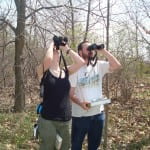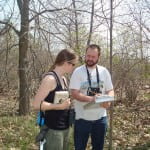Over the weekend, I took a few friends, for their first visit, out to Point au Sable in order to share the beauty and solitude of this wonderful preserve. The weather was gorgeous, with bright sunshine, clear, blue skies, and at least seventy degrees Fahrenheit. Although the wind was far too strong (reaching well over 25 mph) to perform a bird survey, I did observe a few new, season’s first bird species! We ended up hearing the song of a Black-throated Green Warbler and observing a Black-and-white Warbler and a few Caspian Terns. Additionally, we saw numerous Palm Warblers, Yellow-rumped Warblers, House Wrens, and Blue-gray Gnatcatchers, which have been observed at the Point from anywhere between one to three weeks now.
Author: Erin Gnass
Bird Banding at Point au Sable: April 29, 2010 by Erin Gnass
As a part of the UWGB Ornithology class field trips, Dr. Bob Howe set up a bird banding station at Point au Sable as a way to teach the class about how and why ecologists study bird species. Upon catching a bird in a mist net, the banding station’s head bird bander (i.e., Dr. Howe), places a uniquely numbered metal band around the lower part of a bird’s leg. The ultimate goal for an ecologist is to recapture previously banded birds at the same or different banding stations as way to gain information about individual species’ sexes, ages, weights, wing and tail measurements, geographic distributions, and migratory arrival and departure times.
Because the primary wave of spring migration has yet to come, we only caught one bird, a female American Robin, during the 2.5 hours of staying at the banding station. While teaching the class, Dr. Howe and Nick Walton banded the bird and performed multiple measurements on the individual.
However, while we were at the Point, we were fortunate enough to find Forster’s Terns, Killdeer, Palm Warblers, Yellow-rumped Warblers, numerous White-throated Sparrows and Purple Finches, Swamp Sparrows, Ruby-crowned-kinglets, Chipping Sparrows, Barn Swallows, Tree Swallows, Northern Rough-winged Swallows, Purple Martins, House Wrens, Blue-gray Gnatcatchers, White-breasted Nuthatches, Blue Jays, Black-capped Chickadees, several woodpeckers, and many others!




Another special thanks to Kari Hagenow for sharing her photographs.
Photographs from April 28, 2010 by Erin Gnass
Here are a few photographs taken by graduate student, Kari Hagenow. Thank you very much for letting us share these with everyone.




Additional photographs taken by me (Erin Gnass):


April 14, 2010 by Nick Walton
It was mostly cloudy with a light breeze this morning at the Point. The warmer weather has brought in several new migrant bird species. Bonaparte’s Gulls flew past us during two counts with 12 individuals in the larger flock. Swamp Sparrows could be heard singing from the interior wetland. Other new spring migrants included Yellow-rumped Warbler and Eastern Towhee. The Fox Sparrows, which were abundant two-weeks ago, appear to have moved north, but there were still many Hermit Thrushes present. We expect to see White-throated Sparrow and Blue-gray Gnatcatcher soon. Not surprisingly, duck numbers continue to decline. There were only a few Common Goldeneye and Scaup left, but Blue-winged and Green-winged Teal were both seen for the first time this year. Northern Flickers, which are regularly detected at Point au Sable, were particularly conspicuous this morning. They were recorded during all three point counts and were seen or heard frequently while we walked between points. Sadly, European Starlings were seen investigating nest cavities at the end of the Point. One of the resident Bald Eagles was sitting on their nest but we did not see the other parent. All together, we recorded 36 species for the morning.
Observers: Nicholas Walton, Erin Gnass, Kari Petrashek, Ashley Fehrenbach
Photographs of Field Researchers 2010
April 7, 2010 by Erin Gnass
Last night, Green Bay experienced its first, intense spring thunderstorm for the year, which brought along large amounts of rain and wind. I was hoping to find a few new migrants at the Point, but only found twenty-one species, very windy and overcast conditions, and a lot of flooding. Regardless, I was still fortunate enough to find the Fox Sparrows near the middle of point the Point along the edge of some woody shrubs and trees. Song Sparrows and Red-winged Blackbirds were also still very numerous and actively singing and foraging. Within the forest, American Robins, White-breasted Nuthatches, Brown Creepers, Northern Flickers, Downy Woodpeckers, Hairy Woodpeckers, Black-capped Chickadees, Blue Jays, and Golden-crowned Kinglets were present. Along the bay, gulls and American White Pelicans were flying off the shore, and Double-crested Cormorants and at least one hundred Scaup were swimming off the bay. Also, one of mates of the nesting Bald Eagle pair flew overhead along the coastline. Right before leaving the point, I heard a pair of Sandhill Cranes calling off in the distance.
Observer: Erin Gnass


